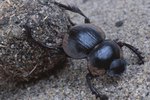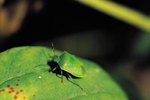
Ladybugs aren't just a colorful and harmless aesthetic addition to your garden; they are also one of nature's best pest controllers. These insects go through four distinct stages of development to complete their life cycle. Their metamorphosis leads to drastic changes in bodily structure as they reach maturity.
Adult
Adults have a circular, dome-shaped body. While you may imagine ladybugs with bright red wings covered in distinct black spots, the wings can also be yellow, orange, black or pink. The colored spots that adorn most ladybugs are meant to warn predators that the insect is not a good source of food, according to the University of Kentucky College of Agriculture, Food and Environment. Adult ladybugs release mildly toxic chemicals when threatened, to discourage birds and other animals from preying upon them.
Egg
Adult females lay eggs near colonies of aphids, mealybugs and other sources of food so their offspring can start eating as soon as they hatch. The females deposit clusters of 10 to 50 eggs at a time and can produce up to 1,000 eggs in a single season, according to Animal Planet Discovery. The eggs are oval in shape and have a orange or yellow color. Egg clusters can be found in protected areas of plants, like the undersides of leaves or along a sheltered portion of a sturdy stem.
Larva
Ladybug larvae are physically similar to caterpillars, although they have more pronounced legs and appear to walk rather than crawl. They are often colorful and their bodies often have distinct color patterns or markings. While the larvae are often mistaken for plant-eating pests, they are actually only interested in consuming aphids and other parasitic insects that suck the life out of plants. This makes them an invaluable resident in gardens and larger agricultural operations, where they are often deliberately introduced. Ladybugs eat voraciously and molt several times during the three to four weeks that they spend in the larval stage.
Pupa
Once the larvae have eaten their fill, they attach themselves to a plant's leaves or stems to begin their final developmental phase. They curl themselves up into a ball and cover themselves in a layer of molting skin. They linger within this "shell" for about a week before emerging as adult ladybugs. The larvae undergo a complete metamorphosis before turning into adults, so their body's structure, color and markings may change completely before the end of the process. The ladybug doesn't move or eat during the pupal stage.
References
Resources
Photo Credits
-
Jupiterimages/Photos.com/Getty Images
Writer Bio
Quentin Coleman has written for various publications, including All Pet News and Safe to Work Australia. He spent more tan 10 years nursing kittens, treating sick animals and domesticating semi-feral cats for a local animal shelter. He graduated from the University of Delaware with a bachelor's degree in journalism.



